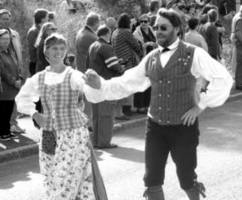
|
The Society of Folk Dance Historians (SFDH)
Historical Notes
[
Home |
About |
Encyclopedia | CLICK AN IMAGE TO ENLARGE |

|
 Rare indeed is the folk dancer who hasn't heard of the Hambo. This top favorite number might well be called one of Sweden's most famous exports.
Rare indeed is the folk dancer who hasn't heard of the Hambo. This top favorite number might well be called one of Sweden's most famous exports.
It is quite appropriate that the Hambo should be the dance which has come to more or less symbolize that northern land's contributions to Folk & Old-time Dancing, for it bears the tradition of just about the oldest of all Swedish dances: the Polska. With a long and interesting history not unrelated to the entire field of Scandinavian folk culture, this unique dance warrants a bit of closer study.
The Polska as both a musical and rhythmic form has been known in Sweden for over three and a half centuries. (Typically in triple measure, it is not to be confused with the 2/4-time Polka, which is of much more recent origin and not native to the north.) The Polska is to Sweden what the Jig and Reel are to the British Isles. Its characteristic three-count lilt constitutes the rhythmic framework for not only the multitude of folk dances and song games based upon it, but for the overwhelming proportion of all Swedish folk melodies as well, both in Sweden proper and in many sections of Finland. In Norway, where it is known as Pols, it finds expression in numerous traditional dances. Truly, this distinctive 3/4-time Polska-Pols rhythm may befittingly be termed "the pulse-beat of the Northland."
 The term Polska appears in Swedish literature as long ago as the late 1500s. While the name itself unmistakably comes from Poland, the Polska as either a dance or musical form is believed by some musicologists to have existed previously in Scandinavia under another name – indeed, that it may even actually have originated somewhere in the North. In any case, the Polska has played a cardinal role in Swedish music and dance since the beginning of the 17th century, reigning supreme as the "national dance" of Sweden for nearly 250 years, well into the 1840s, the favorite of nobility and folk alike.
The term Polska appears in Swedish literature as long ago as the late 1500s. While the name itself unmistakably comes from Poland, the Polska as either a dance or musical form is believed by some musicologists to have existed previously in Scandinavia under another name – indeed, that it may even actually have originated somewhere in the North. In any case, the Polska has played a cardinal role in Swedish music and dance since the beginning of the 17th century, reigning supreme as the "national dance" of Sweden for nearly 250 years, well into the 1840s, the favorite of nobility and folk alike.
During such a long period, it i (long Polska), a serpentine or line dance of the same type as that believed danced in conjunction with folk songs in the Middle Ages. Another form is the Slängpolska (slinging or flinging Polska), which is usually characterized by its being done in place rather than around the floor as in most dances. (Fyramanadans, the Swedish Slengpolska for Four, is a living example of this.)
The Polska, however, is chiefly known as a couple dance, for early in its history it became closely associated with the development of pair-dancing, as distinguished from the more ancient practices of dancing only in groups. As far back as the Middle Ages, European ring dances often concluded with a "swinging" of partners couple-wise, a practice which gave rise to the eventual separation of this figure from the rest of the dance. In Sweden, this partner turn was known as Polska, and as it achieved its "independence," it acquired – in common with the then-current Renaissance court dances – a set of contrasting movements. This usually consisted of a slow first part which passed into a fast, gyrating second part. The former ("fordans," fore-dance), originally in either 4/4 or 2/4 time, was often no more than simple pacing forward while the latter ("efterdans," after-dance) consisted of vigorous whirling roundabout. (This basic arrangement of alternating forward-moving steps and turning steps is still seen in the Hambo of today, particularly the Old Hambo-Polska.)
During the 1700s, a further development in the Polska took place: the two figures separated, and the leisurely fore-dance (which had by then drifted into 3/4 time also, came to be called Polonaise, after the French, while the lively after-dance acquired the name Mazurka, after the Polish. But this was true for the most part only in the higher strata of society. Out in the country districts and among the "common folk" the first part gave way completely to the second, and the spirited latter figure – now a fully independent couple dance in 3/4 time – was referred to variously as Mazurka, Springdans, or more often, simply the original designation, Polska. As far as can be determined, it was solely a turning of partner with any one of various Polska steps.
As in the case with all things dynamic, the Polska never was (nor is today!) the same at all times or in all places. It varied both with the passing of years and with respect to geographical location. For just as there are today various kinds of Waltzes, such as Viennese Waltz, "box" Waltz, "flat-footed" Waltz, etc., so were there in Sweden any number of variations of the Polska, differing with the particular music used and the area in which the dance was done. These forms and variants ran into the scores. Here are a few of the couple dance varieties only: Svängpolska (swinging or wheeling Polska), Körpolska (trotting Polska), Bondpolska (farmer's Polska), Delsbopolska (from Delsbo, Hälsingland – the step used in Snurrbocken), Svingedans (swinging dance), and, in Norway, Springpols (running Polska).
To this day, probably seventy-five percent of all the dance tunes played by Swedish folk musicians are in Polska rhythm. (In the province of Dalarna – Dalecarlia, the "cultural heart of Sweden – the percentage is even greater.) But though many of the old melodies survive among the country fiddlers, the greatest share of the dances originally done to them are lost forever, having succumbed to more modern innovations along the way.
That version of the Polska which has outlived all the others in popularity up into the present generation, is of course the Hambopolska, now generally known as simply the Hambo. Despite the catastrophic toll of folk traditions – including such cultural legacies as rural costumes, folk music, and native dances – taken as a result of the Industrial Revolution and the advent of "modernism," the Hambo has remained a popular dance throughout all parts of Sweden. It is today, as much as ever, dear to the heart of every Swede who knows it, as "the best dance of all."
The specific history of the Hambopolska is somewhat obscure, as is the origin of the word "hambo" itself. Some folk etymologists contend that it comes from the place-name Hansbo, in the province of Halsingland, where folk dancing has long enjoyed a particularly lively existence. Hanebo-polska is in fact known in certain dance circles. Another theory is that it is a corruption of the German city name Hamburg. This is substantiated by the fact that in Swedish literature on dancing from the first part of the 19th century there are references to dances called Hamburg-polska, Hamburger-polska, and Hamburska. (Hamborgapols is a term still in use by folk dancers in Norway.) It seems likely that the name Hamburg-polska may have been used in Sweden to designate a "newfangled" way of doing an old dance. The original dance must have been an existant version of partner-turning Polska; the new styling consisted of prefixing it with a measured number of open pattern steps (such as Tyrolean waltz, Dal steps, or the like). Though the addition of these beginning "ornamentation" steps bears a striking resemblance to this older two-part Polska mentioned earlier, it is most likely that they were at the time an innovation from the Continent. Because Germany was one of Sweden's closest southern neighbors, it is not inconceivable that a German city, Hamburg, was given credit for this imported finesse which brought an old dance "up to date."
Whatever its origin, the Hambopolska soon "took over" as the most popular of the Polska couple dances in Sweden, completely displacing, in many areas, all of the older versions. With the need for differentiation thus eliminated, the word "polska" was gradually dropped, and the dance became known simply as the Hambo. In places where both the old and the new versions were still danced, however, Hambo referred to a Polska with a definite number of introductory steps preceding the turn, and "Polska" to one without such pattern steps. In other instances, the name "Hambo" didn't become known except in connection with written music; traditional airs remained Polskas, not Hambos. (There, incidentally, it is the practice at old-time dances for every other tip to be a Polska!)
From the above account of the Hambo's history, it should readily be seen that the really important, actually vital part of this dance is the basic Hambopolska turning step – that which is done in closed position with a partner. The open pattern steps which may precede and/or alternate with the turn are ephemeral in nature, and of far lesser consequences; indeed, they may even be dispensed with, without greatly detracting from the fundamental enjoyment of the dance.
Thus, though its "ornamentation," and even its name may change from generation to generation and vary from place to place, the traditional, "time-tested" intrinsically Swedish element of the Hambo still remains: the incomparable Polska turn. May it never be lost to the folk dancing world!
DOCUMENTS
- Gordon Tracie, an article.
- Sweden, a country.
Reprinted from the 1954 University of the Pacific (Stockton) Folk Dance Camp syllabus.
This page © 2018 by Ron Houston.
Please do not copy any part of this page without including this copyright notice.
Please do not copy small portions out of context.
Please do not copy large portions without permission from Ron Houston.